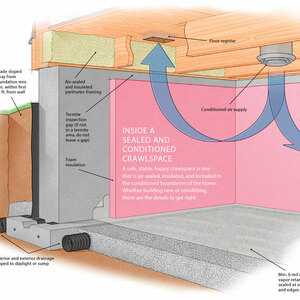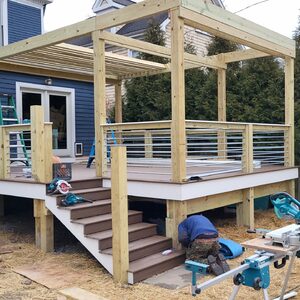We had a nasty problem a couple of weeks ago when a splice in our well pipe failed. I’m trying to work out the best longterm solution and as a side-issue, arguing with the original installer about who gets to pay for the repair work.
The well is about 700ft from the house, beyond the end of our driveway, across the road, down an easement and finally to the shallow well (about 40ft). The original land developers had to provide a conduit between the well and a manhole at the roadside and then one under the road to anothemanhole on our side; after that it was up to use to trench and fill.
Originally we were supposed to have a single length of pipe supplied to go all the way in one go but problems with the conduit under the road meant having to splice in the manhole at the far roadside. What I wasn’t told was that *another* splice was made about halfway between the well and that manhole, for reasons currently unknown. That is what failed after three years, with expensive consequences.
After my doing assorted checks on the power to the well and finding that it was running ok despite no pressure building up at the house nor water appearing anywhere visible we had to call the original installer to help. They arrived pretty quickly and pulled the pump, assuming it must have failed, or blown the check valve, or something like that. Certainly it didn’t seem to be working terribly well to me. After several hours of fiddlig they took it away and promised to return as soon as possible with a replacement pump.
Two days later, they installed a new pump and.. nothing. No pressure, no water. They spent hours getting not much done and certainly no water. We separated the pipe in the manhole and used the neighbour’s well to feed water up to the house, so the problem was clearly between the manhole and well. The plumbers left, handing me a $1000 bill on the way.
I was left to work out what had happened on my own, so I started by guessing the pipe might have broken near the pitless adaptor because of soil compaction perhaps, afte the backfill settled a bit too much. A couple of hours hand digging revealed no break and no apparent wet subsoil that might indicate leakage, but the odd thing was the pipe colour – blue. I knew it was black at the manhole by the road.. so somebody had obviously spliced it. Then the question is how to work out where in 400ft of buried pipe!
Being an engineer that mostly works with software, my immediate thought was to start with a small dig about halfway and see what colour the pipe was there, then split the difference again and again until one hit the actual joint. The problem there was pretty apparent – the pipe is in conduit that turned out to be buried around 4ft deep, with some parts quite a bit deeper. Not really hand-diggable without rather more muscles than I have, so I found a neighbour with a backhoe to help. We spent an entire day digging to find the conduit, making an inspection hole to see the pipe colour and eventually finding a duct-tape wrapped, failed, open joint. Extra fun was to be had since the conduit was full of water and we frequently had to dig extra holes to drain it into before I could inspect the pipe.
The failed joint had been made with a not very big plastic joiner, a couple of hose clamps and some duct-tape (to smooth its journey down the conduit, I guess). At that point I just took a couple of photos and sent them to the plumbers.
Now to give them credit, they turned up early next morning to install a nice brass joint and we soon (After a week!) had working water again. However, I still had to do all the back-filling of the large trench dug to find the problem, not to mention having done the digging in the first place. You’ll understand that I was kind of expecting an apologetic retraction of any billing after their failure to find the problem and having actually caused it in the first place.
I’m not sure of the relevant plumbing code (I’m on Vancouver Island in Canada) nor really even of where I would look to find it, but I’m told by a neighbour who installs wells and septics systems etc that there should be a manhole access whereever there is a splice, just like there has to be an electrical box for any wiring joint. If this is correct then I’m going to have to install one and complain at the plumber for not having done so originally. At least they damn well ought to have told me there was a splice and decently marked where it was!
So, obviously I’m pretty miffed about all this. We had no water for a week and got sent a large bill, and had to pay excavators and I had to spend three days not earning, and I’d very much welcome advice on how this ought to be resolved.
- Did the plumbers fail me by not mentioning & marking the splice?
- Do I need to add an access point for the splice?
- Should I be paying the plumber for not fixing the problem?
- Any ideas on how I can reinforce the splice; it’s subject to the pump’s 70-ish psi thumpings.


















Replies
I am not a plumber, so figure that into what I say
Where they failed you was in leaving before the problem was fixed, and in billing you before it was fixed.
Maybe they could not buy 400' of pipe in one continous piece. I typically get it 300' on a roll. Maybe they were working wih what they had rather than getting a new roll.
But where you failed was in DIYing all that digging. My first choice would be to demand that they finish the job before letting them hand me a bill. As a tradesman, I want to be done and know what the problem is first and last.
My method of fixing might have been to pull the pipe out of the conduit and insert a full length, depending on lots of variables I can't see and know from here, but that is the purpose of using a conbduit - to make replacement easy without all that digging